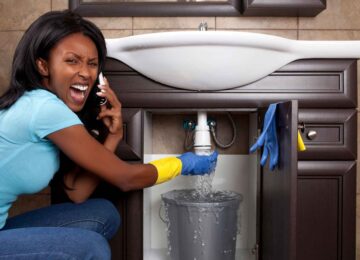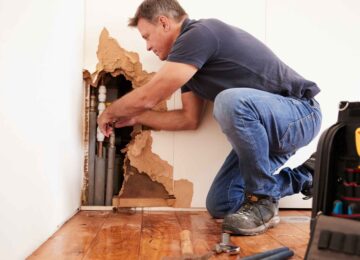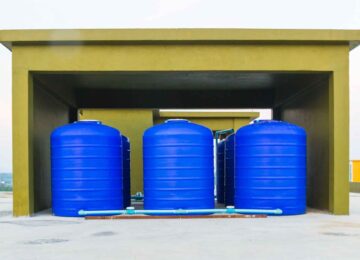A water heater not working can be more than just an inconvenience; it can halt your daily routine entirely. Whether you’re stepping into a cold shower or discovering dishes still coated in grease because there’s no hot water, it’s a frustrating disruption. For homeowners in Connecticut and New York, especially during colder months, hot water isn’t a luxury; it’s essential.
Your water heater is one of the most important appliances in your home. Like any hardworking system, it can fail over time due to age, neglect, or technical issues. But how do you know what’s wrong and whether it’s something you can handle, or if it’s time to call a professional?
In this guide, we’ll walk through the five most common reasons your water heater may stop working, how to spot the warning signs, and what actions you can take, whether it’s resetting a thermostat, clearing sediment, or picking up the phone for expert help.
1. Tripped Circuit Breaker or Blown Fuse
When an electric water heater stops working, one of the most common reasons is a tripped circuit breaker or blown fuse. These water heaters operate on high-voltage appliance circuits, often with dedicated lines in your home’s electrical system.
The first place to start is the fuse box or breaker panel. Look for any switches labeled “water heater” and make sure they’re in the ON position. If you see that the switch is flipped to the middle or OFF position, reset it by turning it fully off and then back on.
You should also check the reset button on your electric heating element, usually found behind a metal panel on the water heater. If this red button has tripped, push it in. Give it about 30 minutes to reheat water.
If the breaker keeps tripping after a reset, it may point to a thermostat problem or an electrical issue with the heating element, which needs professional inspection.
Signs this might be the problem:
- No hot water at all
- No power to the unit
- Breaker won’t stay on
2. Faulty Thermostat or Heating Element
If your electric water heater is not heating, a faulty thermostat or heating element is a likely culprit. These parts regulate the temperature and generate the heat needed to warm the water in your tank.
A typical electric model has two thermostats and two heating elements, one at the top and one at the bottom. If only one element is working, you might notice lukewarm water instead of completely cold water.
Testing the element requires turning off the power and using a multimeter to check continuity. If the test fails, the heating element must be replaced. The same applies if the upper thermostat is not working properly, it can prevent both elements from activating.
Common symptoms:
- Water only gets warm, not hot
- Hot water runs out quickly
- Temperature isn’t consistent
Because dealing with high-voltage appliances involves safety risks, it’s often safer to leave element testing and replacement to licensed professionals.
3. Pilot Light Is Out (Gas Water Heaters)
If you have a gas water heater, the pilot light plays a vital role. This small flame stays lit to ignite the gas burner, which heats the water. When the pilot light goes out, the system won’t heat at all.
Common reasons include:
- A faulty thermocouple
- A draft blowing the flame out
- Dirt or debris around the pilot
- Issues with the gas valve or natural gas supply
Before relighting the pilot light, always read your owner’s manual. Follow instructions carefully and smell for gas before proceeding. If you detect any gas leak odor, shut off the valve and call your gas provider immediately.
To relight a pilot light (basic steps):
- Turn the gas control knob to “OFF” and wait 5–10 minutes.
- Switch to “PILOT” and press it down while lighting.
- Hold for 30–60 seconds, then release and turn to “ON.”
If the pilot light won’t stay lit, it could mean a bad thermocouple or a failing gas control valve, both require a technician’s help.
4. Sediment Buildup in the Tank
Over time, minerals in your water, especially if you have hard water, settle to the bottom of your tank. This sediment buildup reduces efficiency and can lead to rumbling noises, lukewarm water, or even cause your water heater to leak.
As sediment collects, it creates a barrier between the heating element and water. The heater has to work harder, increasing energy bills and shortening its lifespan.
Signs of sediment issues:
- Water takes longer to heat
- Noises like popping or rumbling
- Discolored or cloudy hot water
How to fix it:
- Turn off the power or gas supply
- Attach a hose to the drain valve
- Open a hot water faucet in your home
- Drain and flush the tank until clear
Regular maintenance, including annual tank flushing, prevents this buildup and keeps your water heating system energy efficient and working properly.
5. Old Age or Internal Failure
Even the best-maintained heaters don’t last forever. Most units have a lifespan of 8 to 12 years, depending on usage and water quality. After that, corrosion, rust, or damaged components may lead to total failure.
Key parts like the anode rod (which protects against corrosion) and the expansion tank (which manages pressure) degrade over time. When these fail, leaks and internal damage often follow.
Common signs your water heater is aging out:
- Rust-colored water
- Pooled water around the base
- Frequent repairs or inconsistent heating
If your water heater is over 10 years old and you’re constantly dealing with issues, replacement may be the smarter investment. A newer unit will be more energy-efficient and safer.
Gas vs Electric Water Heaters: Key Differences
Understanding whether you have a gas or electric model matters when troubleshooting. Each type has unique components and symptoms when they malfunction.
| Feature | Gas Water Heater | Electric Water Heater |
|---|---|---|
| Heat Source | Natural gas | Electric heating element |
| Common Failures | Pilot light, thermocouple | Thermostat, heating element |
| Reset Function | None (manual re-light) | Reset button available |
| Smell Concern | Gas leak | Burnt wire or tripped breaker |
| Energy Efficiency | Lower (older models) | Can be higher (with upgrades) |
If you’re unsure, check your owner’s manual or contact a licensed plumber to identify your unit type and assess the issue.
What to Do First When There’s No Hot Water
When your water heater isn’t working, don’t panic. Start with a simple 3-step emergency checklist to identify the issue:
- Double-check the power or gas supply – Make sure your circuit breaker or gas valve is in the correct position.
- Inspect for leaks, noises, or rust – These are red flags that your unit needs service.
- Try the reset button – For electric water heaters, this quick fix can sometimes restore power.
If none of these steps work, avoid further DIY attempts, especially if you’re unfamiliar with plumbing or electrical systems. Safety first.
When to Call a Professional
Not every water heater issue requires a new unit, but some require professional support. If you experience any of the following, it’s time to call an expert:
- You’ve reset the breaker multiple times and still have no hot water
- You smell natural gas or see a leaking water heater
- You hear loud banging or hissing inside the tank
- Your heating elements have failed and need replacement
If you’re in Danbury, Ridgefield, Wilton, or anywhere in Fairfield or Westchester County, the licensed experts at All State Plumbing Pros are available 24/7 for emergency service and water heater repair. We provide fast, honest, and clean work, whether you need a quick reset or a full unit replacement.
Conclusion
A water heater not working can cause major headaches, especially when you rely on it daily for comfort and cleanliness. However, understanding the most common reasons behind these issues and taking appropriate action can help you avoid costly repairs or replacements.
Whether your system needs a reset, a new heating element, or a full replacement, All State Plumbing Pros has you covered. We’re available 24/7 for water heater repair, well pump service, and emergency plumbing across Connecticut and New York. Call us today to restore your hot water and peace of mind.
FAQs
What are the common causes of a water heater not working?
Common causes include a tripped circuit breaker, faulty thermostat, burned-out heating element, pilot light failure (for gas units), or sediment buildup in the tank. In older units, corrosion or a damaged anode rod may also be responsible.
What is the first thing to check when there is no hot water?
Check if your unit is getting power or gas. For electric models, inspect the breaker panel and reset button. For gas units, make sure the pilot light is still on.
How do I reset my water heater?
Turn off the power at the breaker. Open the panel on the water heater and press the red reset button. Wait 30 minutes to see if it restores hot water. If not, further inspection may be needed.
What is the most common cause of no hot water?
In electric heaters, it’s usually a tripped breaker or a bad thermostat. In gas units, a blown-out pilot light is common. Sediment buildup and old age can also lead to loss of heat.

![Water Heater Not Working? 5 Common Issues and What to Do Next A water heater not working can be more than just an inconvenience; it can halt your daily routine entirely. Whether you’re stepping into a cold shower or discovering dishes still coated in grease because there’s no hot water, it’s a frustrating disruption. For homeowners in Connecticut and New York, especially during colder months, hot water […]](https://allstateplumbingct.com/wp-content/uploads/2025/07/Water-Heater-Not-Working-750x420.jpg)



Leave a Reply